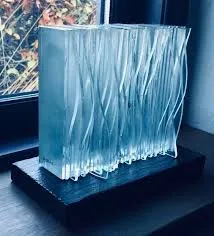Thermal Tempering of Glass An Overview
The process of thermal tempering of glass plays a crucial role in various applications, providing enhanced strength, safety, and aesthetic appeal. This method involves heating glass to a high temperature—typically around 600 to 700 degrees Celsius—followed by a rapid cooling phase. This controlled thermal treatment alters the internal structure of the glass, resulting in significant changes in its physical properties.
The primary objective of thermal tempering is to increase the strength of the glass. When glass undergoes heating, it reaches its softening point where it becomes pliable. During this heated state, the surface of the glass is cooled rapidly, while the core remains hotter for a slightly longer period. This differential cooling creates compressive stresses on the surface while generating tensile stresses within the glass. The result is a material that is significantly stronger than its non-tempered counterpart, making it less prone to breaking under impact or thermal stress.
One of the most notable benefits of tempered glass is its safety. Standard glass, when broken, shatters into sharp, jagged pieces that can cause serious injuries. In contrast, tempered glass breaks into small, blunt pieces, reducing the risk of severe injury upon breakage. This characteristic makes tempered glass an ideal choice for applications in buildings, vehicles, and other environments where safety is a paramount concern.
Thermal tempering also enhances the thermal resistance of glass. Tempered glass can withstand higher temperature variations than standard glass. This feature is particularly advantageous in environments that experience extreme temperatures or rapid temperature changes, such as commercial kitchens or glass facades in high-rise buildings. The ability to resist thermal shock ensures longevity and durability, making it a preferred choice for architects and builders.
thermal tempering of glass
Moreover, the aesthetic qualities of tempered glass cannot be overlooked. The smooth, polished finish of tempered glass adds a modern touch to any design. Available in various thicknesses and sizes, tempered glass can be customized to meet specific architectural requirements, offering versatility in design solutions. Its clarity and brilliance contribute to an airy, open feeling in interior spaces, making it popular in modern architecture.
In addition to safety and aesthetic advantages, thermal tempering also plays a role in energy efficiency. The increased strength and durability of tempered glass allow for larger panes without compromising safety concerns. This means that architects can design larger windows, thereby maximizing natural light and reducing reliance on artificial lighting. The integration of tempered glass in buildings contributes to energy-efficient designs, ultimately leading to lower energy consumption.
While thermal tempering offers numerous benefits, it is essential to understand that the process requires careful handling during the manufacturing stage. The need for precision in heating and cooling is critical to avoid any defects or weaknesses in the glass. Professional tempering facilities are equipped with specialized ovens and cooling systems that ensure consistent and uniform heating and cooling processes.
In conclusion, thermal tempering of glass is a vital process that enhances the strength, safety, and aesthetic appeal of glass products. Its ability to withstand thermal stress and reduce injury risks makes it an essential material in modern construction and design. As technology advances, the applications of tempered glass continue to expand, finding its place in residential, commercial, and industrial settings alike, all while contributing to energy efficiency and contemporary architecture. The future of glass design is undoubtedly bright, with thermal tempering leading the way.
 Afrikaans
Afrikaans  Albanian
Albanian  Amharic
Amharic  Arabic
Arabic  Armenian
Armenian  Azerbaijani
Azerbaijani  Basque
Basque  Belarusian
Belarusian  Bengali
Bengali  Bosnian
Bosnian  Bulgarian
Bulgarian  Catalan
Catalan  Cebuano
Cebuano  Corsican
Corsican  Croatian
Croatian  Czech
Czech  Danish
Danish  Dutch
Dutch  English
English  Esperanto
Esperanto  Estonian
Estonian  Finnish
Finnish  French
French  Frisian
Frisian  Galician
Galician  Georgian
Georgian  German
German  Greek
Greek  Gujarati
Gujarati  Haitian Creole
Haitian Creole  hausa
hausa  hawaiian
hawaiian  Hebrew
Hebrew  Hindi
Hindi  Miao
Miao  Hungarian
Hungarian  Icelandic
Icelandic  igbo
igbo  Indonesian
Indonesian  irish
irish  Italian
Italian  Japanese
Japanese  Javanese
Javanese  Kannada
Kannada  kazakh
kazakh  Khmer
Khmer  Rwandese
Rwandese  Korean
Korean  Kurdish
Kurdish  Kyrgyz
Kyrgyz  Lao
Lao  Latin
Latin  Latvian
Latvian  Lithuanian
Lithuanian  Luxembourgish
Luxembourgish  Macedonian
Macedonian  Malgashi
Malgashi  Malay
Malay  Malayalam
Malayalam  Maltese
Maltese  Maori
Maori  Marathi
Marathi  Mongolian
Mongolian  Myanmar
Myanmar  Nepali
Nepali  Norwegian
Norwegian  Norwegian
Norwegian  Occitan
Occitan  Pashto
Pashto  Persian
Persian  Polish
Polish  Portuguese
Portuguese  Punjabi
Punjabi  Romanian
Romanian  Russian
Russian  Samoan
Samoan  Scottish Gaelic
Scottish Gaelic  Serbian
Serbian  Sesotho
Sesotho  Shona
Shona  Sindhi
Sindhi  Sinhala
Sinhala  Slovak
Slovak  Slovenian
Slovenian  Somali
Somali  Spanish
Spanish  Sundanese
Sundanese  Swahili
Swahili  Swedish
Swedish  Tagalog
Tagalog  Tajik
Tajik  Tamil
Tamil  Tatar
Tatar  Telugu
Telugu  Thai
Thai  Turkish
Turkish  Turkmen
Turkmen  Ukrainian
Ukrainian  Urdu
Urdu  Uighur
Uighur  Uzbek
Uzbek  Vietnamese
Vietnamese  Welsh
Welsh  Bantu
Bantu  Yiddish
Yiddish  Yoruba
Yoruba  Zulu
Zulu 

